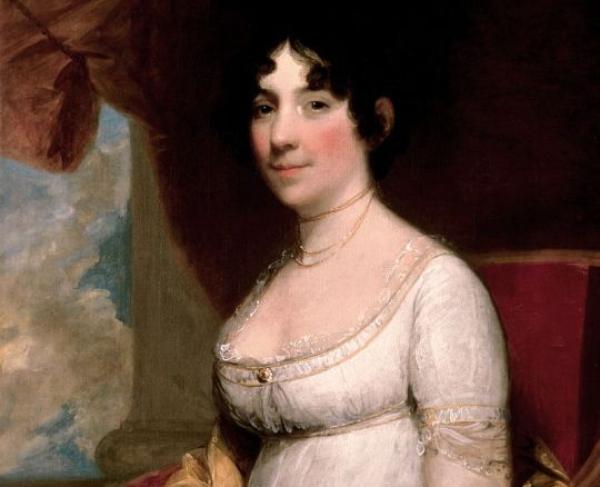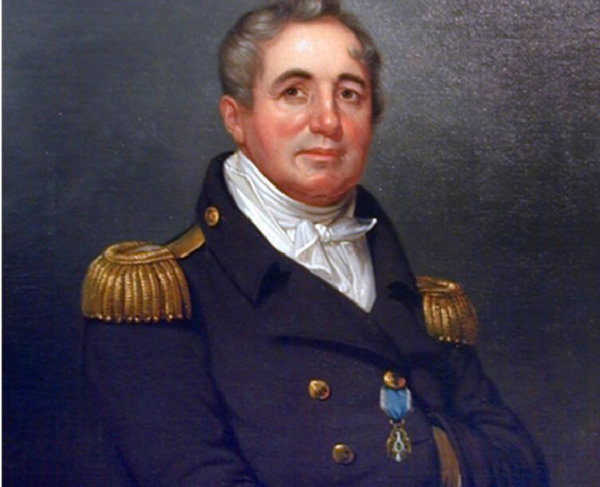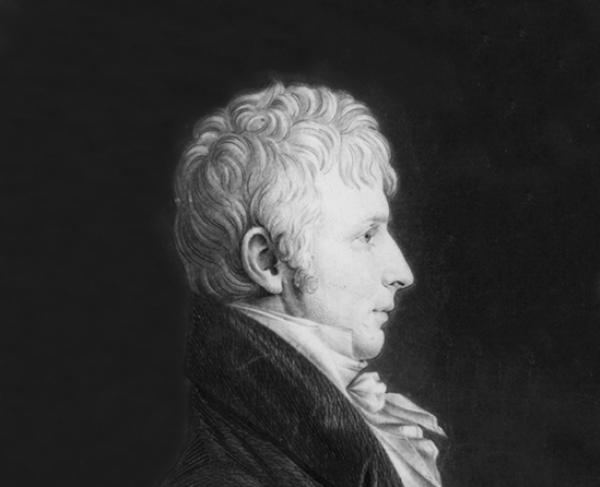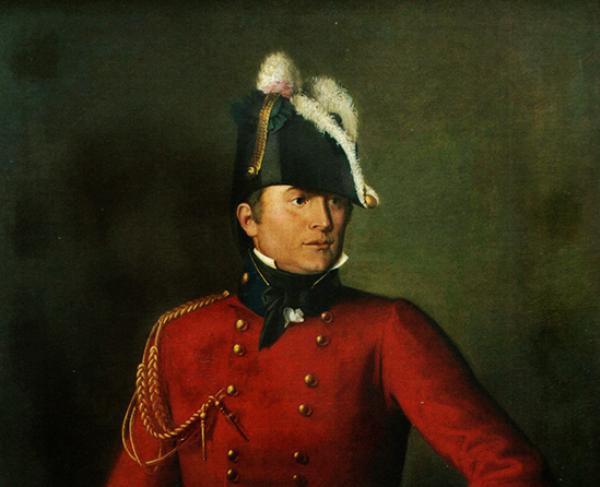Dolley Madison

One of the most intriguing women to emerge from the pages of American history is Dolley Madison, the wife of America's fourth president, James Madison. Long before the term ‘first lady’ was coined, Dolley Madison set the standard for the role of the President’s spouse until it was even further defined by Eleanor Roosevelt in the 1930s and 1940s.
James Madison was a short, balding, and soft spoken intellectual, seventeen years older than his bride. Dolley was gregarious and unreserved in her warmth--much more of a people person than her husband. While the Madisons occupied the Executive Mansion after James election in 1808, Dolley was known as the “Lady Presidentess.” Dolley was soon the social pivot of the new capital. In an age of fierce party partisanship, Dolley engaged everyone in what became very popular public functions. Her ebullient nature increased Madison’s popularity as President. Madison was quiet and reserved and often felt uncomfortable in the public and ceremonial demands of his office. Dolley provided the needed equilibrium to their marriage and to Madison’s Presidency.
Born in 1768 to Mary Coles and John Payne, Quakers in North Carolina, Dolley was raised on a plantation in Tidewater Virginia. Her father was a slave-owner who, after the War for Independence, manumitted his slaves, in part because of his Quaker affiliation and because of a groundswell of the ideals of liberty stemming from the war. In 1782, when the Virginia General Assembly legalized manumission of slaves, Virginia Quakers took the lead in the endeavor. In 1783, Payne moved his family to Philadelphia, the hub of the Quaker community, where he tried his hand unsuccessfully at being a merchant.
It was in Philadelphia, however, where Dolley blossomed. A lifelong friend, Anthony Morris, wrote to Dolley’s sister Anna in 1837 describing Dolley this way, “She came upon our comparatively cold hearts suddenly with all the delightful influences of a summer sun.” In the same letter he gushed that Dolley’s radiance raised “to fever heat the thermometers of the heart.” In 1792, John Payne died, leaving his wife Mary with the unenviable task of being a woman who tried to make ends meet. Mary eventually returned to Virginia, and Dolley stayed behind in Philadelphia where she married a Quaker lawyer, John Todd, in 1790. They had two sons, John Payne and William Temple. Anna Payne, Dolley's sister, moved into the Todd household to help raise the family.
In 1793, Philadelphia was hit with a yellow fever epidemic, which claimed more than 5,000 lives, including Dolley’s husband and three month-old son, William Temple, as well as her father- and mother-in-law. Despite being widowed at twenty-five with a young son to care for, Dolley doggedly retained her charm.
Philadelphia served as the interim capital of the United States from 1790-1800, while Washington, DC was being built in the wilderness along the banks of the Potomac River. At this time, James Madison, a rising star in the Jeffersonian Republican Party, was serving as a representative from Virginia in the United States House of Representatives. Though shy, Madison still attended social functions in the capital, and it was probably at one of these events that Dolley and James caught each other’s eye.
In 1794, Aaron Burr, a friend of Madison’s, formally introduced the couple. Madison, 43, a life-long bachelor was smitten with the beauty. A serious romance soon blossomed between the two, and, after a brief courtship, they were married in September 1794. Since Madison was not a Quaker, Dolley had married outside her religious affiliation and was banished from the community. The Madisons lived in Philadelphia until 1797 when James, hoping to retire from politics, moved the family to his parents’ plantation, Montpelier, in Orange County, Virginia. The urbane Dolley struggled with life on the Virginia Piedmont, as she was more accustomed to the whirlwind activity of city-living.
When Thomas Jefferson was elected President in 1800, he asked Madison to serve as his Secretary of State. Madison obliged his good friend’s request, and once more Dolley moved; this time to the growing, though still rural, Washington, DC. Since Jefferson was a widow, Dolley often served as his hostess, all the while refurbishing the Executive Mansion to reflect the residence of a man of prestige. After serving two terms, Jefferson stepped aside as President, and Madison was elected in 1808 and then reelected in 1812.
Always dressed fashionably with her hair adorned with feathers and sporting the latest European fashions, Dolley jumped head-long into organizing the nascent Washington social scene. However, her most legendary achievement in the minds of most Americans is the role she played in saving important Executive Mansion documents before the British put the house to the torch in 1814 during the War of 1812. She singlehandedly ordered the full length, 8 foot by 5 foot, 1796 Gilbert Stuart portrait of George Washington removed from its frame, and spirited out with whatever else she could save before the British arrived.
As the Battle of Bladensburg, Maryland raged just northeast of Washington, DC, bedlam reigned in the city as people scrambled to secure all of their possessions before the impending arrival of the British. Panic ensued at the Executive Mansion as well. A self-possessed Dolley took control of the situation, her demeanor only cracking with anxiety about the Washington portrait. “Save that picture!" were her orders barked out to those around her. “Save that picture if possible. If not possible, destroy it. Under no circumstances allow it to fall into the hands of the British!”
In a letter to her sister she recalled the iconic moment, “Our kind friend Mr. Carroll has come to hasten my departure, and in a very bad humor with me, because I insist on waiting until the large picture of General Washington is secured, and it requires to be unscrewed from the wall. The process was found too tedious for these perilous moments; I have ordered the frame to be broken and the canvas taken out"..... "It is done, and the precious portrait placed in the hands of two gentlemen from New York for safe keeping. On handing the canvas to the gentlemen in question, Messrs. Barker and Depeyster, Mr. Sioussat cautioned them against rolling it up, saying that it would destroy the portrait. He was moved to this because Mr. Barker started to roll it up for greater convenience for carrying." Rather than risk cracking the paint it was gingerly moved flat.
Her husband had been out observing military operations during the Battle of Bladensburg and was caught up in the panic as American forces fled into the city. Dolley crossed over the Potomac River and found sanctuary for herself and what she had saved in Northern Virginia. Madison eventually caught up with her. Returning to find all the public buildings in Washington with scorched facades, the Madisons took up residence in the home of DC resident John Tayloe, in what became known as Octagon House, until the Executive Mansion could be restored. It would be in this building that Madison learned of the successful negotiations of the Treaty of Ghent, which ended the War of 1812 on December 24, 1814.
Probably the greatest single loss in the fire was the collection of the Library of Congress which was wiped out. Such a significant loss was deeply felt by Thomas Jefferson, leading to his donation of many books from his own personal library. These serve as the basis of the current collection, now housed in three buildings that make up the Library of Congress campus.
Keeping with the tradition of serving two terms in office, Madison relinquished the Presidency to his former Secretary of State, James Monroe, who was elected to the office in 1816. The Madisons then returned to Montpelier. Dolley continued to find life in Orange County, Virginia stifling, though she did enjoy entertaining the Marquis de Lafayette during his triumphal American tour in 1824.
Madison, who had been plagued all his life with physical infirmities, most notably rheumatism, declined in health after returning to Montpelier. With each passing year, he became increasingly frail, depending on Dolley to minister to his physical needs. After James died in June 1836, Dolley remained at Montpelier for only one more year before returning to live in Washington, D.C. until her death in 1849.
By the time she died, she was living in a state of near poverty. Her son Payne Todd, who had been directed to maintain the family holdings and manage the plantation at Montpelier, was an alcoholic gambler who never fulfilled his duty to the family, landing in debtor’s prison. In order to make some money, Dolley sold Montpelier and its enslaved community in an effort to pay off mounting debts. A year before she died, Congress agreed to buy the papers of James Madison, which helped only a small fraction in alleviating Dolley’s dire financial straits. When she died in 1849, she was given a grand funeral in Washington, DC, led by President Zachary Taylor. Initially buried in Congressional Cemetery in 1858, her remains were moved back to Montpelier, where she was interred next to her husband.
Related Battles
200
250


